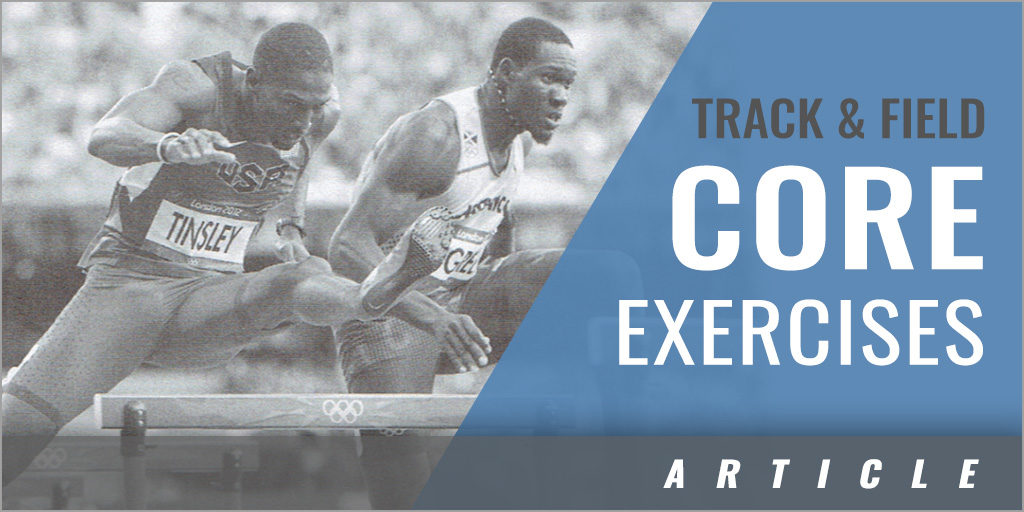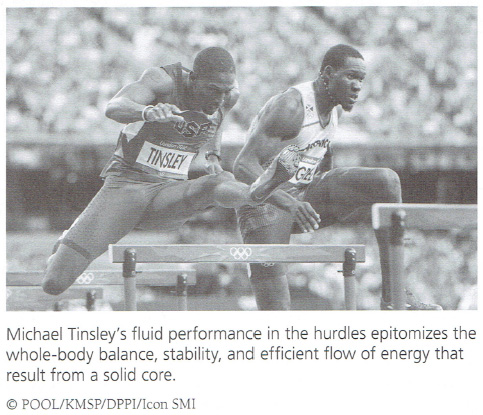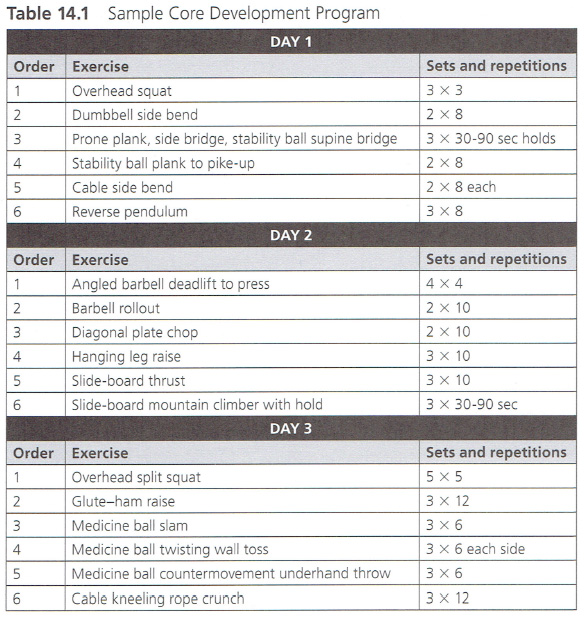|
By: Jeffrey Kipp Originally Published in: Developing the Core Provided by: Human Kinetics Track and field events place heavy demands on the core musculature. An athlete with deconditioned core muscles will have decreased efficiency, power output, and performance. The core musculature connects the upper and lower extremities and acts as a link between them during movement. Regardless of the event, well-conditioned core muscles create fatigue resistance and movement efficiency, allowing an athlete to maintain proper posture and technique. Furthermore, increasing core muscle strength can help track and field athletes effectively control or resist applied external forces (e.g., pole vault and inertia in sprints) as well as apply force to implements (e.g., javelin, shot, and discus). Increasing core muscle strength and power also contributes to greater whole-body balance and stability. With each step, jump, or glide, the maintenance of whole-body balance and stability can be attributed to how quickly the core musculature resists the downward pull of gravity. When the core musculature is weak or deconditioned, forces are not effectively transferred through the kinetic chain, resulting in inefficient movement and wasted energy from muscle elasticity (i.e., energy leakages) during sprinting, jumping, pole-vaulting, or throwing events. Energy leaks may occur as a sprinter leaves the blocks, continuing through the acceleration phase with each step, or for a jumper during the approach, takeoff preparation, and takeoff in the long jump and the high jump. Energy leaks may also be detrimental to throwing performance in the shotput, weight throw, hammer throw, javelin, and discus, as less of the ground reaction force is ultimately transferred to the implement. For the pole vault, the energy leaks may occur during the approach, plant, and takeoff as well as the swing-up, extension, and turn, decreasing the force transferred through the pole to propel the athlete over the bar. An analogy to illustrate the leakage of energy is the pogo stick. The shaft of a pogo stick is straight and made out of a material that provides the desired bouncing outcome. The shaft is strong enough to allow even a full-grown man to bounce around like a child. The shaft is made straight and rigid for a reason. When force is applied to the pogo stick down the shaft, the force is immediately returned back up the shaft, resulting in the desired bouncing effect (i.e., liftoff from the ground). If the shaft of the pogo stick becomes dented or bent, energy is lost at that spot, resulting in a reduced response or even breakage. Additionally, if a pogo stick were made of a less rigid material, more energy would be lost, with a related decrease in the bouncing effect.
A second analogy to illustrate the need for cylindrical strength in the core muscles is one of a soda or pop can. Assuming that the sides of the can do not have any weaknesses (deformities or dents), a person may apply force to the top of the can without crushing it. However, if one or both sides of the can are dented, then the can will collapse. The sides of the cylinder work as a unit to resist the forces being applied from top to bottom. Thus, small weaknesses in the integrity of the core musculature can cause a decreased reactivity to the external forces that are applied to the body. Conditioning the athletic cylinder (i.e., core musculature) also provides the necessary stiffness to effectively apply forces that are transferred distally to the upper and lower extremities. The exercises used to develop the core musculature for the track and field athlete will start out early in the off-season with low-intensity, higher-volume basic movements or isometric holds. Over the course of the off-season and into the preseason, the exercises should become more dynamic and increasingly unstable, with greater specificity to each event. Loads for the weighted exercises begin early in the off-season, with low loads and high volumes. With increases in strength, the loads get higher as the overall volume decreases. When using body-weight exercises, the volume will increase over the course of the program. Recovery intervals lengthen for the throwing athletes; higher loads are used; and complete recovery is necessary for consistently high power output with each repetition. Pole-vaulting and sprint events should use shorter rest intervals, higher volumes, and circuit or superset-style core development programs to promote fatigue resistance. Distance runners should primarily use isometric holds and short rest intervals to promote muscular endurance and efficiency. The sample program that follows (table 14.1) is intended to show the basic concept in planning a program for track and field athletes. Additional training of the core muscles takes place throughout the workout when Olympic movements and ground-based strength training exercises are utilized.
The sample program represents a general core muscle development program that can be applied to all track and field athletes. The exercises listed should be considered supplementary to other Olympic weightlifting movements (and variations) as well as ground-based movements (e.g., squats, lunges, rows, overhead presses) that also involve the core musculature. For greater specificity based on the event, throwing athletes might perform a greater frequency of medicine ball tosses; sprinters and hurdlers might perform a greater frequency of isolated joint actions for the hip-joint (i.e., abduction, adduction, flexion, extension) on a multi-hip machine; and jumpers and pole-vaulters might perform a greater frequency of hip flexion and extension movements with body weight (e.g., stability ball plank to pike-up for pole-vaulters; side double-leg lift for high jumpers; and jackknife for long jumpers). |









